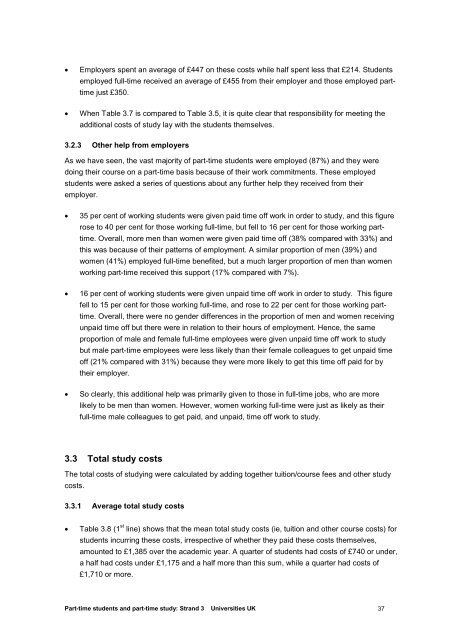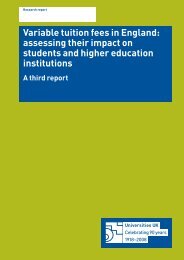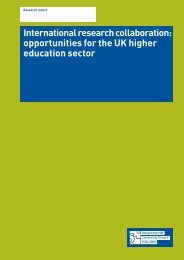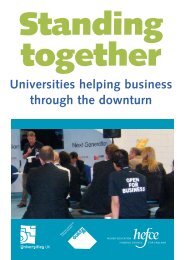Part-time Students And part-time Study In Higher ... - Universities UK
Part-time Students And part-time Study In Higher ... - Universities UK
Part-time Students And part-time Study In Higher ... - Universities UK
You also want an ePaper? Increase the reach of your titles
YUMPU automatically turns print PDFs into web optimized ePapers that Google loves.
• Employers spent an average of £447 on these costs while half spent less that £214. <strong>Students</strong>employed full-<strong>time</strong> received an average of £455 from their employer and those employed <strong>part</strong><strong>time</strong>just £350.• When Table 3.7 is compared to Table 3.5, it is quite clear that responsibility for meeting theadditional costs of study lay with the students themselves.3.2.3 Other help from employersAs we have seen, the vast majority of <strong>part</strong>-<strong>time</strong> students were employed (87%) and they weredoing their course on a <strong>part</strong>-<strong>time</strong> basis because of their work commitments. These employedstudents were asked a series of questions about any further help they received from theiremployer.• 35 per cent of working students were given paid <strong>time</strong> off work in order to study, and this figurerose to 40 per cent for those working full-<strong>time</strong>, but fell to 16 per cent for those working <strong>part</strong><strong>time</strong>.Overall, more men than women were given paid <strong>time</strong> off (38% compared with 33%) andthis was because of their patterns of employment. A similar proportion of men (39%) andwomen (41%) employed full-<strong>time</strong> benefited, but a much larger proportion of men than womenworking <strong>part</strong>-<strong>time</strong> received this support (17% compared with 7%).• 16 per cent of working students were given unpaid <strong>time</strong> off work in order to study. This figurefell to 15 per cent for those working full-<strong>time</strong>, and rose to 22 per cent for those working <strong>part</strong><strong>time</strong>.Overall, there were no gender differences in the proportion of men and women receivingunpaid <strong>time</strong> off but there were in relation to their hours of employment. Hence, the sameproportion of male and female full-<strong>time</strong> employees were given unpaid <strong>time</strong> off work to studybut male <strong>part</strong>-<strong>time</strong> employees were less likely than their female colleagues to get unpaid <strong>time</strong>off (21% compared with 31%) because they were more likely to get this <strong>time</strong> off paid for bytheir employer.• So clearly, this additional help was primarily given to those in full-<strong>time</strong> jobs, who are morelikely to be men than women. However, women working full-<strong>time</strong> were just as likely as theirfull-<strong>time</strong> male colleagues to get paid, and unpaid, <strong>time</strong> off work to study.3.3 Total study costsThe total costs of studying were calculated by adding together tuition/course fees and other studycosts.3.3.1 Average total study costs• Table 3.8 (1 st line) shows that the mean total study costs (ie, tuition and other course costs) forstudents incurring these costs, irrespective of whether they paid these costs themselves,amounted to £1,385 over the academic year. A quarter of students had costs of £740 or under,a half had costs under £1,175 and a half more than this sum, while a quarter had costs of£1,710 or more.<strong>Part</strong>-<strong>time</strong> students and <strong>part</strong>-<strong>time</strong> study: Strand 3 <strong>Universities</strong> <strong>UK</strong> 37
















